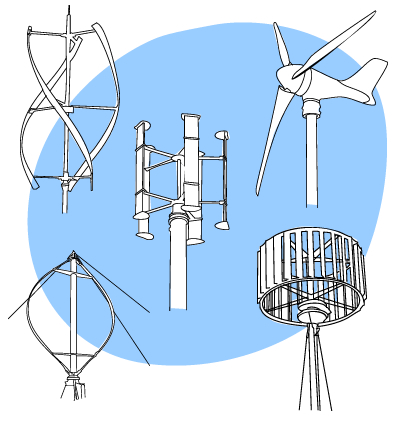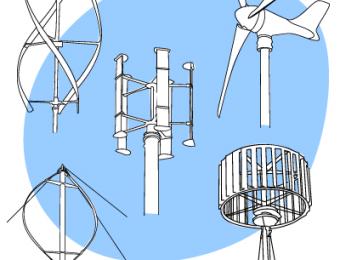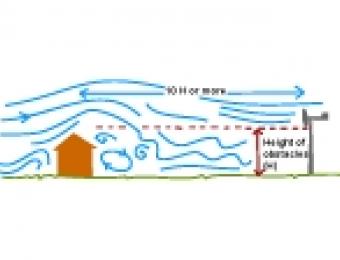
There are many different variations on the theme of wind turbines - some with different purposes, benefits and usages. Broadly speaking, wind turbines can be broken down into two main varieties: HAWTs and VAWTs.
What are HAWT wind turbines?
HAWT stands for horizontal axis wind turbine. These are the more traditional windmill-type turbines that look vaguely like a large propeller at the end of a tall pole or tower. The blades of the turbine spin on a horizontal axis, so they need to be pushed out far enough from the base so that high winds won’t bend them back into the mast. This type of turbine is typically angled forward into the wind.
These types of turbines rely on being faced into the wind, so they usually incorporate a tail fin to keep the blades facing the wind. This also helps to avoid problems with turbulence from the mast. HAWTs are commonly found on rural properties where the construction of a tall tower or mast won’t draw too much objection from neighbours. Most wind farms use these types of towers, as the strain on the horizontal axis is a lot lower, which means less maintenance issues over time.
Having said that, as the rotor needs to be directly behind the blades, any maintenance required can be made more difficult by the heights involved. Likewise, in areas where the wind changes direction often, the constant change in direction can add to wear and tear.
What are VAWT wind turbines?
VAWT stands for vertical axis wind turbine. These turbines are more useful in urban and low-lying areas where the direction of the wind is frequently changing. The blades on a VAWT spin around like a carousel on a vertical axis, driving the crank to produce power. The key advantage with VAWTs is that they don't need to be faced into the wind, as the blades will spin regardless of which way the wind is coming from. This makes them ideal for areas where the wind direction is less predictable.
Because of the additional torque on the axis, VAWT systems are less efficient and generally require more maintenance than HAWT systems. On the positive side, these types of turbines are easier to maintain, because the rotor housing doesn't have to be hoisted high up in the air, and is therefore far easier to access. VAWTs are less commonly found in Australia, and are more popular in Europe and the US.
Types of VAWT
Below is a rundown of a few of the different types of VAWTs, and how they work:
- Darrieus wind turbine – These wind turbines look a little like whisks with slender curved blades creating a cage-like configuration.
- Giromill – This type is like the Darrieus, but with straight blades instead of curved ones.
- Savonius wind turbine – This turbine utilises scoops instead of blades, and relies on drag rather than wind lift. The scoops spin because the wind has less resistance on one side of the scoop than the other. This results in less efficiency, but can be used in areas where cost and reliability are a higher factor for consideration. These types of turbines are often used for ventilation on caravans and buses.
- Twisted Savonius – By changing the shape of the scoops to solid blades twisting around the axis, efficiency can be improved by reducing the loss of energy in drag. These are often used in urban wind energy generation where the changing direction can be a problem for a fixed HAWT.





